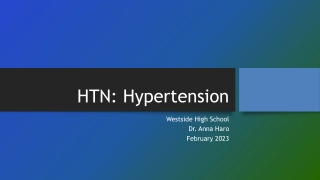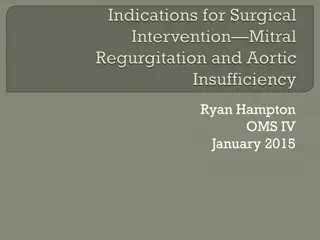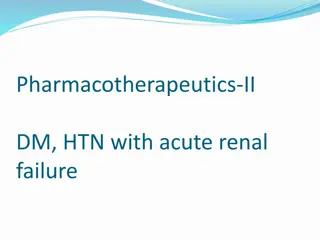
Management of Hypertension: Guidelines, Recommendations, and Lifestyle Changes
Discover the latest recommendations and guidelines for the treatment of hypertension based on JNC 8, ISH, ESH, and WHO. Learn about the panel appointed by NHLBI, routine investigations, the 2013 ESH/ESC guidelines for arterial hypertension management, and modifications to reduce blood pressure. Explore lifestyle changes, including salt intake, alcohol moderation, exercise goals, and more to reduce cardiovascular risk factors.
Download Presentation

Please find below an Image/Link to download the presentation.
The content on the website is provided AS IS for your information and personal use only. It may not be sold, licensed, or shared on other websites without obtaining consent from the author. If you encounter any issues during the download, it is possible that the publisher has removed the file from their server.
You are allowed to download the files provided on this website for personal or commercial use, subject to the condition that they are used lawfully. All files are the property of their respective owners.
The content on the website is provided AS IS for your information and personal use only. It may not be sold, licensed, or shared on other websites without obtaining consent from the author.
E N D
Presentation Transcript
Treatment of Hypertension Based on the latest recommendations of JNC 8, ISH, ESH, WHO Kamran Mohammadi MD 2
Panel appointed by the National Heart, Lung, and Blood Institute (NHLBI) First guidelines (JNC-1) published in 1977 Subsequent updates published in 3- to 6-year intervals Last edition (JNC-7) published in 2003
An initially elevated office blood pressure (BP) mm Hg diastolic either by home or ambulatory BP monitoring or must be remeasured at least three times over a period of at least Only if the office BP level is very high ( ( 180 organ damage before the diagnosis is carefully established. office blood pressure 140 mm Hg systolic or must always be (BP) higher than higher than 140 mm Hg systolic or 90 must always be confrmed 90 confrmed either by home or ambulatory BP monitoring, at least three times over a 4 weeks office BP level is very high 110 mm Hg) or if symptomatic target organ damage is present should therapy begin period of at least 4 weeks 180/ /110 or if symptomatic target- -
Routine investigations Routine investigations CBC U/A for protein and blood Cr , Na , K FBS Blood lipid profile EKG
2013 ESH/ESC Guidelines for the management of arterial hypertension Lifestyle changes for hypertensive patients Lifestyle changes for hypertensive patients Recommendations to reduce BP and/or CV risk factors Salt intake Restrict 5-6 g/day Moderate alcohol intake Limit to 20-30 g/day men, 10-20 g/day women Increase vegetable, fruit, low-fat dairy intake BMI goal 25 kg/m2 Waist circumference goal Men: <102 cm (40 in.)* Women: <88 cm (34 in.)* Exercise goals 30 min/day, 5-7 days/week (moderate, dynamic exercise) Quit smoking The Task Force for the management of arterial hypertension of the European Society of Hypertension (ESH) and of the European Society of Cardiology (ESC) - J Hypertension 2013;31:1281-1357 Medical Education & Information for all Media, all Disciplines, from all over the World Powered by
Modification Approximate BP reduction (range) Weight reduction 5 20 mm/10 kg wt loss 8 14 mmHg Adopt DASH eating plan Dietary sodium reduction 2 8 mmHg Physical activity 4 9 mmHg Abstinence from alcohol 2 4 mmHg 7
Rule of Halves in HT : For every 800 400 Of them only 200 Of them only 100 Of them only 50 Of them in only 25 Means 25 800 adults in the community 400 are HT (either SBP or DBP or both) 200 are diagnosed 100 are started on treatment 50 are on correct drug 25 the goal B.P 25 400 diagnosed HT started on treatment correct drug goal B.P. is attained = 6 6% only have goal BP 400 = % only have goal BP 9
SBP (mm Hg) DBP (mm Hg) Category Normal < 120 < 80 Pre hypertension 120-139 80-90 Hypertension Stage 1 140 159 90 99 Stage 2 160 and above 100 and above 10
3 critical questions for adults with hypertension: When to start therapy? How low should I go? What drug do I use?
In patients >60 years of age, start medications at blood pressure of >150/90mm Hg and treat to goal of <150/90mm Hg
In patients <60 years of age, start medications at blood pressure of >140/90mm Hg and treat to goal of <140/90mm Hg In all adult patients with diabetes or chronic kidney disease, start medications at blood pressure of >140/90mm Hg and treat to goal of <140/90mm Hg
. Keep B.P. < 140/90 mm Hg in each patient This may be revised to 120/80 may be ? 110/70 MRFIT MRFIT s cut off values are s cut off values are 115 115/ /75 75 mm Hg mm Hg . 15
In most of the patients of hypertension Two drugs Two drugs are required for adequate control. are required for adequate control.
Hypertension 17
(1) Calcium channel blockers (CCBs). Calcium channel blockers (CCBs). (2) inhibitors, either enzyme inhibitors (ACEIs) or receptor blockers (ARBs). ) Renin inhibitors, either angiotensin enzyme inhibitors (ACEIs) or angiotensin receptor blockers (ARBs). Renin- -angiotensin angiotensin system (RAS) angiotensin- -converting system (RAS) converting angiotensin (3) Thiazide Thiazide- -type diuretics type diuretics.
beta drugs for h/o ACS and heart failure or palpitation. Atenolol beta- -adrenergic blockers are drugs for h/o ACS and heart failure or palpitation. Atenolol vs adrenergic blockers are frst frst- -line line vs non non atenolol atenolol BB. BB.
A C ACEI, ARB Ca-Blockers B D Diuretics -Blockers 20
AGE AGE Renin Renin Younger p. High Renin Older p. Low Renin HT CCB Diuretic ACE BB 21
ARB ARB ACEi ACEi CCB CCB DIU DIU BB BB Enalapril Lisinopril Captopril Losartan Valsartan Metoprol Carvedio Atenelol Labetolol Proprano Amlodep Verapam Diltiazem HCTZ Chlortha Furosemi Spirono Triamter 22
Reassess treatment monthly Avoid ACEI/ARB combination Consider 2 2- -drug initial therapy for Stage HTN (> 160/100) The best combination Goal BP not reached with 3 drugs, use drugs from other classes Consider referral to HTN specialist monthly ACEI/ARB combination drug initial therapy for Stage 2 2 The best combination is A+C A+C Consider referral to HTN specialist
JNC 8 ESH/ESC >140/90 Eldery SBP >160 AHA/ACC ASH/ISH >140/90 < 60 yr >150/90 >60 yr >140/90 <80 yr >150/90 >80 yr Threshold for Drug Rx Consider SBP >140/90 140-150 if <80 yr B-blocker First line Rx No Yes No No Initiate Therapy w/ 2 drugs >160/100 "Markedly elevated BP" >160/100 >160/100
Once life. Tolerability Cost Unlike diuretics and RAS inhibitors, a high salt diet or concurrent NSAID therapy not compromise the effectiveness of amlodipine. Once- -daily daily dosing because of its long half Tolerability. Cost. a high- - salt diet or concurrent NSAID therapy does
Verapamil limited usefulness because of dose- dependent constipation. Verapamil is weakly antihypertensive is weakly antihypertensive and has Diltiazem between and is usually well tolerated. Diltiazem is intermediate in potency between verapamil and is usually well tolerated. potency dihydropyridines verapamil and the and the dihydropyridines
The principal side effect of the amlodipine is dose With amlodipine, ankle edema is far more common with a 10-mg dose than with 2.5- or 5-mg doses. This edema appears to be vasogenic because of selective arterial dilation and can respond to concomitant therapy with an ACEI or ARB balanced arterial and venous dilation. dose- -dependent ankle edema dependent ankle edema. can respond to concomitant therapy with an ACEI or ARB that causes
As monotherapy, ACEIs are generally less effective in lowering BP in black patients and in older patients. with low-renin hypertension, but they are quite effective in these groups when combined with a low CCB black patients and in older patients. quite effective in these groups when combined with a low- -dose diuretic or CCB. dose diuretic or
All RAS inhibitors are contraindicated in pregnancy. The most common side effect of ACEIs is a dry cough Hyperkalemia In patients with stage 3 CKD with proteinuria, initiation of ACEI or ARB therapy is often associated with a small transient increase in serum creatinine; therapy can be continued unless the elevation in 30 temporarily withhold therapy. All RAS inhibitors are contraindicated in pregnancy. dry cough. Hyperkalemia. . elevation in creatinine %, an indication to decrease the dose or creatinine is greater than is greater than 30%,
Even though HCTZ has enjoyed widespread use in clinical practice, chlorthalidone choice for practicing evidence medicine. chlorthalidone, a thiazide-like diuretic that is more potent and longer lasting than HCTZ chlorthalidone is the based is the choice for practicing evidence- -based medicine. more potent and longer lasting than HCTZ .
Loop diuretics agents and should be reserved for treating hypertension in the setting of advanced CKD (stage Chlorthalidone may also be effective in patients with stage 3 CKD. Diuretics enhance the potency of all other classes of antihypertensive agents. Loop diuretics are less effective BP-lowering stage 3 3 or higher or higher). Diuretics enhance the potency of all other classes of antihypertensive agents.
Glucose intolerance (particularly in higher doses and when used in combination with a beta blocker), Hypokalemia hyponatremia precipitate gout, and elevate serum lipids. erectile dysfunction. These drugs have higher discontinuation rates. in higher doses and when used in combination with a beta blocker), Hypokalemia , , hypomagnesemia hyponatremia especially in older adults hypomagnesemia, and severe especially in older adults , and severe erectile dysfunction. higher discontinuation rates.
Standard beta blockers increase the risk for diabetes, particularly when combined with a diuretic. Common side effects such as fatigability cause high discontinuation rates. precipitate acute bronchospasm All beta gain. fatigability cause high discontinuation rates. bronchospasm. All beta- -blocking drugs promote weight gain. blocking drugs promote weight
They are effective add diffcult are useful in older men with prostatism add- -on therapy for on therapy for diffcult hypertension hypertension and prostatism. Major Side effect Major Side effect: orthostatic hypotension orthostatic hypotension
Resistant hypertensiondefined as: high BP uncontrolled with three or controlled with at least four antihypertensive drugs (including a diuretic prevalence of secondary hypertension worse CV and renal outcomes. With aging of the population, of resistant hypertension is increasing and is estimated to affect 13 adult U.S. population. high BP uncontrolled with three or controlled with at least four antihypertensive drugs (including a diuretic) is associated with a higher prevalence of secondary hypertension and associated with a higher , the prevalence the prevalence 13% to % to 20 20% of the % of the adult U.S. population.
In the absence of an identifable cause of the hypertension, spironolactone or a vasodilating beta blocker (carvedilol) can serve as highly effective add-on therapies.
Hypertensive crises are a heterogeneous group of hypertensive disorders characterized by : severe hypertension damage blood vessels. Typically, BP is may be much lower in women with preeclampsia hypertension such that cerebral autoregulation has not been reset. Hypertensive crises require immediate reduction of BP with intravenous medication and intra- arterial monitoring in an intensive care unit. severe hypertension and acute target damage to the brain, heart, kidney, retina, or acute target- -organ organ BP is 220 220/ /130 130 mm mm Hg or higher but preeclampsia who do not have preexisting immediate reduction
In contrast, hypertensive urgency denotes severe uncontrolled hypertension without evidence of acute target In the absence of symptoms and acute target-organ damage, a patient with a BP of 220/130 mm Hg should be treated with a short severe uncontrolled hypertension without evidence of acute target- -organ damage. organ damage. short- -acting oral medication acting oral medication.
Severe hypertension, defned as a BP of 180 symptoms or acute target almost always occurs in patients with chronic hypertension who ran out of or stopped taking their BP medication. Long restarted. Patients with either hypertensive urgency or severe hypertension up within care physician or hypertension specialist. 180/ /110 symptoms or acute target- -organ damage almost always occurs in patients with chronic hypertension who ran out of or stopped taking their BP medication. Long- -acting oral medication 110 mm Hg to mm Hg to 220 220/ /130 130 mm Hg without organ damage, mm Hg without acting oral medication can simply be Patients with either hypertensive urgency or severe hypertension require outpatient follow up within 24 follow 24 to to 72 72 hours hours by either a primary
In patients with impaired cerebral , ,labetalol cerebral blood flow than nitroprusside does but has a longer half adverse episodes of systemic hypotension. In patients with impaired cerebral autoregulation labetalol causes a smaller adverse fall in autoregulation longer half- -life, which leads to more adverse episodes of systemic hypotension. life, which leads to more Intravenous nicardipine more predictable and consistent reduction in BP than labetalol does, but with a similar safety profle; however, physicians and hospital pharmacies are less familiar with nicardipine. nicardipine appears to produce a
Resistant to goal Severe hypertension: > 180 hypertensive urgency: > >220 HYPERTENSIVE with TOD Hypertension: not achived 180/ /110 220/ /130 220/ /130 110 130 130 CRISES: > >220 with TOD
Hypertensive encephalopathy is characterized by a reduced level of consciousness, delirium, agitation, stupor, seizures, or cortical blindness in the setting of acute severe high BP. Focal neurologic signs ischemic or hemorrhagic stroke rather than encephalopathy. Hypertensive encephalopathy is a cause of reversible posterior syndrome, which is often seen in the setting of cyclosporine hypertension recipients) or that caused by bevacizumab or bortezomib. a reduced level of consciousness, delirium, agitation, stupor, seizures, or cortical blindness Focal neurologic signs are rare and suggest ischemic or hemorrhagic stroke rather than encephalopathy. Hypertensive encephalopathy is a cause of reversible posterior leukoencephalopathy syndrome, which is often seen in the setting of cyclosporine- - or hypertension (particularly in heart transplant are rare and suggest leukoencephalopathy or tacrolimus tacrolimus- -induced induced
Brain computed tomography or magnetic resonance imaging showing areas of cerebral edema confrms the diagnosis of encephalopathy. The edema typically localizes in posterior brain regions arteries, innervation and thus less dampening of BP oscillations than the carotid arteries do. The areas of brain edema will resolve with timely treatment of the hypertensive crisis. The edema typically localizes in posterior brain regions perfused arteries, which have less sympathetic perfused by the vertebral by the vertebral The areas of brain edema will resolve with timely treatment of the hypertensive crisis.




